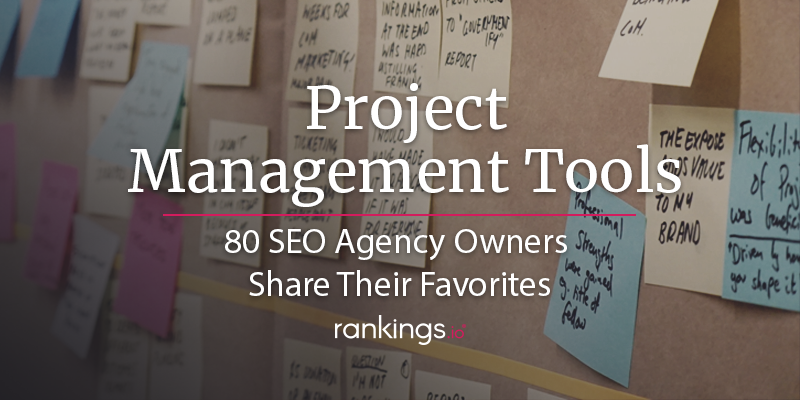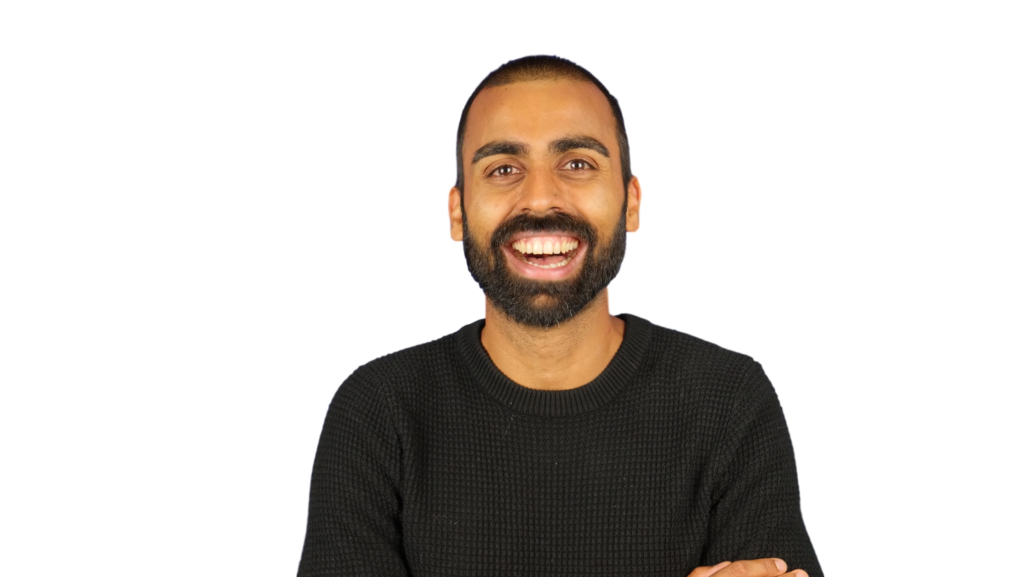Project management tools facilitate teamwork by organizing the tasks, tracking the time, and measuring the progress of each team member. Agencies use this software to improve workflow and communication among employees, enabling them to deliver high-quality services and/or products to their clients. These tools are particularly important if the company has employees that work remotely.
Choosing the best project management tool for your company depends on the number of employees you have, the features that you need, and if a tool is user-friendly and easy to use.
To help you determine what tool fits your needs best, we hired Minuca Elena to reach out to 80 SEO agency owners and ask them the following question:
Which project management tool does your agency use and what made it the best choice for your business?
In addition, the experts were also required to share how many employees they have. You can find the results in the table below. If you want to read about a specific tool and skip the rest of them, then just click on the tool’s name and it will take you to all the experts that recommended it.
[ninja_tables id=”24333″]
There are others mentioned by the experts, but each received only one vote:
There are also a few agency owners interviewed who don’t have one favorite tool; rather, they use a mix of two (or even three).
Below are the tools that are used in combination with other similar software and the number of times they were mentioned:
Trello (3), Slack (3), Asana (2), Teamwork (1), Meistertask (1), Paymo (1), Toggl (1).
Lastly, there were a pair of companies that use their own proprietary project management software (ProofHub and Sputnik).
Trello
Patrick Langridge – Screaming Frog
We use a number of different project management tools to help in our work, but I think the one we couldn’t do without would be Trello.
Not only is it a great tool that lets our various teams collaborate most effectively on projects, but the amount of automation you can do with it also makes it a real time-saver. It’s our centralized point of managing all projects where we can reference documents, set deadlines and assign tasks.
As our agency has many projects running concurrently, we need a tool that manages all of the moving parts for us, to ensure we stay on top of tasks and meet deadlines.
Marie Haynes
We use a few tools when it comes to project management. We started off using Asana, but for some reason, it just didn’t click for us. So now, we use a combination of several tools.
We use WorkFlow Max for several things. It helps us track time and determine which of our projects are the most profitable. To be hones90t, though, we are still working out the multiple ways we can use this tool.
We also use Slack and Google Docs, Spreadsheets and Calendar to help us coordinate scheduling and other tasks.
Personally, I use Trello regularly to help me manage my day to day tasks. I have a list for “things to get done today” which I try to put no more than 5 items on. I have a list for “things to get done this week” and set realistic goals for myself.
David Leonhardt – SEO Writer 
We’ve used several project management tools at several different times, often based on the project and the clients involved. I would probably say that while we have rarely used a tool to manage most projects, the few times we have, it’s been Trello.
For the most part, all the major tools are similar, but Trello just seems to be more user-friendly, like it’s easier to set up each task and keep track of progress. As each task hits another milestone, the task moves visually across the screen, so people who don’t use it often won’t get lost.
I follow the KISS principle when it comes to tools, so the simpler it is to onboard clients or subcontractors, the better.
Brian Swanson – FlashPoint Marketing
The primary project management tool we use is Trello. Since we have professionals working from different locations, and countries in some cases, it permits users to organize workflow between staff in a systematic and orderly manner.
It’s helpful for assigning routine tasks and tracking projects across various areas and permits management to identify where any “jams” are occurring.
Finally, the staff loves the ability to slide the task status as it’s a visually appealing way to show specifics tasks have been completed.
Servando Silva – Stream SEO
We use Trello to manage our website/marketing projects.
While we have tested other apps like Asana and recently an awesome app named ClickUp, we decided to go back to Trello because it’s the app we have been using for 2 years already and we like the simplicity of it.
In our case, we just need the app to manage keyword research planning, link building, and monetization. We don’t really need the app to be integrated with Gmail, Slack or calendars as many people do when working and answering directly to clients, so Trello has pretty much everything we need in a simplistic way that allows us to perform our weekly tasks in a timely manner and everybody can be in the loop checking the status of each part of the process.
However, if you have a very convoluted system that requires integration with many other platforms, synchronization with calendars, slack, skype, and all that jazz, while also managing your employees I definitely recommend you to give ClickUp a try.
I find it much more complete than the typical tools most people use. It’s just not as famous as other apps and you don’t hear much about it in general.
Andrew Scherer – Marketer’s Center
I have done wonders with Trello and Trello Butler.
A lot of folks already know about Trello so I won’t speak too much on it, you’ll probably get quite a few answers talking about Trello, but I never hear anyone talk about the automation power behind Trello’s Butler.
Butler allows you to put together a veritable virtual assistant symphony. Automations, rules, triggers, buttons, and more can all tie in with other boards and cards. I used Trello for years before I experienced the power behind Butler and now we’re using it with a lot of success. What we previously would have to have a manager do, Butler now does automagically.
As a project management tool Trello is already a solid choice. We’re already using it not only for our marketing teams but also for our content and development teams.
But with Butler hooked up to it, it allows us to streamline a lot of our processes and keep our standard operating procedures as simple and small as we can.
Brogan Renshaw – Firewire Digital
At Firewire Digital we use Trello to organize and manage all of our SEO Projects. I have tried other things in the past like Excel or Google Sheets and whilst they both have their benefits, Trello is by far the best. Its simplicity is what makes it so good.
You don’t need a week-long training course to use Trello. It is one of the easiest and quickest project management tools I have used. One of the great things is how easy it is for employees to pick up.
The biggest benefit to our SEO agency is keeping on top of everyone’s task. All staff can see where someone else is up to on a specific task. The ability to quickly see the progress, what is being done, look back at completed tasks all within one program is invaluable.
Chris Makara
I use a few different platforms depending on the client and type of work I am doing. However, the majority of the time I use Trello. The main reason is that most of my clients are familiar with it or already using it. Plus if others haven’t used it before, it’s pretty easy to learn.
I like it because the mobile app makes it easy to manage things on the go if I’m not in front of my computer. Not to mention the variety of power-ups you have to choose from to add additional functionality.
Dmitriy – MiroMind
At Miromind, we’ve been using Trello for a couple of years now. It’s a simple yet very efficient tool for managing different tasks between employees. We can create multiple boards and manage privacy settings. We can set deadlines and notifications that help us reach our goals more efficiently.
We can assign members to different boards and tasks and use a filter that allows everyone to focus on their own tasks while still seeing the big picture.
Recently, Trello added a cool function of assigning buttons that we can customize to perform specific actions with one click, like moving the task to a different board or assigning priority.
We also used Teamwork and Jira before but decided to proceed with Trello as it satisfies our needs.
Mads Singers
I run multiple businesses, but in most we use Trello – The main reason is that it’s super easy to pick up and figure out, particularly if you have boards where clients get involved.
I work with a lot of clients and reality is that most project management tools are very similar and people spent a ton of time cycling around between them.
My general recommendation to most is really just pick one and stick with it and make sure everyone in your team uses it consistently, as that is really the key behind getting the most out of any project management tool.
Tim Stoddart – Stodzy Internet Marketing
As the owner of Stodzy Internet Marketing, I needed to find the most efficient project management tool to keep all of my clients and work in order. I found Trello to be the most beneficial as my business is remote, meaning I have employees working from out-of-state.
While using Trello, there is a dashboard where users can view their priorities, forecasted and current projects, as well as accessing content that needs to be written and leads that would be beneficial to contact.
Trello allows me to instantly share personalized boards with employees and co-workers that display exactly what work needs to be completed and in what order. My employees and I can easily view the progress on each task as well.
As an added bonus, Trello integrates all of the external apps that my business relies on, allowing me to have all of my content in one place. Trello is accessible on all platforms, so if one of my employees has a question about a client, I can easily access everything from my phone on the off-chance that I’m not in my office.
Minal Lohar – SRV media
As a marketing agency, it’s essential to organize all of our deadlines and client communication in one place. After months of trying different tools, we finally decided to give Trello a shot.
Surprisingly, it met every single need we had from a project management tool. It’s easy to set up and doesn’t require a hefty subscription fee.
The platform made keeping track of our sales lead, customer contacts, client communication, and internal communication more comfortable and faster. The fact that every team involved could access information whenever needed was an added bonus. We were able to easily customize our boards based on our specific requirements, thus making the entire process of project management more effortless.
Trello is similar to having a note pad and sticky notes, only that everything is online and easily accessible. Moreover, unlike a post-it note, Trello makes it easier to understand when we are approaching a deadline, thanks to the add due date option. Looking at a date in bright red sure does remind you of an approaching deadline!
And finally, because Trello is mobile-friendly, even those working remotely or on the way to a client meeting can immediately check the progress on their particular project!
Prafull Sharma – LeadsPanda
At LeadsPanda, we are using Trello with great success in managing our content marketing projects and tasks. We are a remote team of 35 and growing. Trello provides our team with a simple overview of what is getting done and who is doing it.
Managers can see complete project pipeline and manage, assign, reassign, and move tasks easily. We organize our projects into boards and use cards for associated tasks. Each card has a detail description of tasks, relevant file attachments, and a checklist to be completed to ensure proper execution.
One of the biggest advantages has been the ability for new team members to quickly learn the tool and get on-boarded because it’s so easy.
Antonella Pisani – Eyeful Media
We used tools like Trello to manage replicable projects and scheduled tasks early on but quickly outgrew its feature set.
We’re currently testing different tools including a combination of Monday and Toggl for project management and time tracking. This pairing seems to be productive for both our W2 and contract employees.
As an agency owner, this allows me to monitor our workload and ensure we are delivering on our commitments.
Eagan Heath – Get Found Madison
I own and run an SEO agency and we use Trello. We recently upgraded to premium, so that was a big decision moment.
Its main strengths have been:
Being able to easily see the status of other people’s tasks
Nice visual interface with keyboard shortcuts that can make you quick
How easy it is to duplicate our template boards and tasks, and also cross-reference our how to material.
ASANA
Marcus Miller – Bowler Hat
At Bowler Hat, we use Asana for all of our project management. Ultimately, it is just such a flexible tool and allows us to manage the majority of our workflow outside of email.
A key feature for us is project templates. We can create a template for SEO or PPC clients of different shapes and sizes and whilst no SEO project is the same, having a project starting point to adjust based on our audit findings ensures we have a clear plan from day one.
Where we have regular or repeating tasks Asana allows us to schedule tasks to automatically repeat ensuring that everybody, across all the teams, knows what they need to do.
We also use Asana for managing internal projects and the flexibility to utilize agile style boards so we can build up a backlog and work through tasks is super useful.
They just keep adding features as well – it’s almost as if they know what we want almost before we do! A new and useful feature is task dependencies – so one task that is dependant upon another.
Asana is now a fundamental part of how we manage projects and run our business at Bowler Hat.
Corey Trojanowski – Valve+Meter
Over a year ago, we made the shift to agile marketing. We knew we needed to work quicker and be more flexible as an agency to the changing conditions our clients face. Agile is a tactical approach to marketing where our team collectively identify high-value projects on which to focus their collective efforts.
Using week-long sprints, we self-assign projects and tasks in Asana so we know what work is expected of each of us at all times.
Asana allows us not only to track the progress of on-going projects, but it also gives us a backlog, or parking lot for future projects, so that we can keep moving forward on what’s important today and set the stage for future projects at the same time.
Our sprint weeks are cataloged in a single place, rather than living in emails or Slack channels that can be siloed from the rest of the team.
Without question, the shift to agile and using Asana as our project management tool has increased our productivity and capacity to take on additional work from our clients. We’re producing better, measurable results that directly impact our agency’s bottom line.
Joy Hawkins – Sterling Sky
Our local SEO agency uses Asana for our project management software. We elected to use this for a couple of reasons that serve our team nicely.
Primarily, Asana is a web-based application, so our team members can access their entire workload from anywhere, including their phone via the app. That makes working and getting answers easy, particularly for a remote team with members throughout North America.
Secondly, Asana offers a lot of customization with regards to adding tags for status-updates, sharing notes and images for internal processes, stopwatch for billing, and general ease of tracking.
Finally, Asana does a great job of alerting the team when projects are coming to a head and needs attention before their scheduled deadline. We find this particularly helpful, as we’re in our growth stage and that means we’re hiring more and introducing more moving parts into our local ecosystem.
Whenever a company grows, one of the more paramount concerns should be retaining the quality of work as you achieved when you were boutique. I believe Asana has helped us with this growth by allowing us to see at that 30,000-foot perspective!
Matt Bentley – Can I Rank

The fact that Asana automatically populates to-do lists for all of our marketers keeps our workflows agile while ensuring that everyone is able to keep track of priorities and complete work on time.
We especially love the new automation features that handle simple administrative functions that add up over time.
Instead of having many different tools to keep track of client work, communications, documentation, etc, Asana allows us to keep everything in one place.
This greatly decreases the time it takes to complete both simple and complex tasks without having to jump back and forth between platforms.
Account leads have instant oversight into the health of each account and a medium to communicate our success with clients in a way that is easy to understand.
It also allows our clients to see work as it progresses through the pipeline and increases our transparency, which is something that our clients really value
Jeff Romero – Octiv Digital
There are several project management tools on the market that can simplify the way an agency handles its business. From Trello to Hubspot, there are plenty of free and paid tools to make project management easy.
After establishing our agency, we quickly discovered we needed a shared tool to manage and communicate about projects between our team (7 people) and our clients. Knowing how non-transparent most agencies are about a client’s work, it was really important for us to find a tool that could be client-facing as well.
With a bit of research and testing, we landed on Asana. Asana is a popular project management tool and allows for collaboration among our team and the client.
Our clients ask questions on the platform where we can answer right away. Not only does it help us keep everything organized, but we’re also delivering a customer service experience our clients love.
Asana connects with our internal communication tool as well (Slack) which helps make everything seamless. We can easily see who is working on what, if they have any questions about a project and what the next deliverable is. Asana is free up to a certain number of users and if you have a small team as we do, it’s the best option.
Bernice Quek – Traffic Bees
We use the Asana tool to manage our projects.
As an SEO content marketing agency, we work with clients across different verticals. Therefore, it’s important that Asana allows us to
- organize our tasks based on each client project
- set the due date (and time)
- assign to the relevant person in charge
- explain the task in the task description
- attach documents
- leave comments
- create subtasks
As most of us work remotely, we sync Asana to a time tracking tool (Harvest) to track our employees’ working hours and productivity.
Asana is great as we can turn on email notifications when there are updates for the tasks that we are following.
Aside from basic features, there’s also a calendar function to review all the deadlines at a glance. It provides a comprehensive overview of each employee’s workload and progress, which is important for a start-up when we’re assessing our capacity to (1) achieve goals for our existing clients and (2) take on more clients.
Lucy Kirkness – Pandable
We have tried every single task or project management system and have settled with Asana. It’s a feature-rich tool and has (almost) all of the functionality we need to run our projects. For anything more custom, it has the ability to add custom fields that we can then use to filter and specific task attributes to our needs.
As most of our work is on a retained basis, and for mid to large clients, we use a separate ‘team’ for each client. Unlike separate Trello boards, with Asana we can see cross-project reports, for example:
– all tasks due in 7 days
– all tasks marked for review
With custom fields and filtering options, the reports become extremely powerful.
Asana is also extremely intuitive and pleasing to use, letting our team spend more time on work than they are fussing around with the PM tool.
Kornel Kurtz – WebTek
To keep both projects AND people organized in one tool, we use Asana. The desktop website and mobile app have proven to be extremely effective (and fun) for the team here to use.
It’s kind of like one giant, shared checklist where team members can write updates, statuses, opinions, and feedback to a space where everyone involved can see it.
I personally like this tool because it also sends emails and notifications when your project is soon due, when there has been an update, or when it’s been completed. Not to mention, a fun animated graphic flies across the screen once you complete a longstanding task!
Asana is the tool that’s kept us organized for the past few years and we definitely intend on continuing to use it more in the upcoming years! And the best part is – it’s free!”
Kelsey Jones – Six Stories
We use Asana for project management because it is the most user-intuitive and easiest to use.
I also like their Workload view to see what projects people are busy with.
Other tools I like a lot include Basecamp, ToDoist, and Notion.
Bailey Hahn – Summit Digital Marketing
At Summit Digital Marketing, we use Asana for our project management software. We use Asana because you can easily create layouts of ongoing workflows that can be duplicated for all clients.
Also, you can track the client’s status as a whole for on-boarding and launch purposes. I personally also love the Calendar view in Asana because I can see the week’s tasks at a glance to help prepare myself and organize my time management.
In addition, there is an awesome Asana Gmail extension where you can easily add emails as TASKS to your team’s Asana and assign it to the correct person straight from your email. This feature definitely helps our team keep track of responsibilities that otherwise may get lost in an inbox.
Ali Pourvasei – LAD Solutions
The project management tool we use at our agency is Asana.
What makes it the best choice for us is its affordability along with ease of use.
It allows us to create goals/tasks for each team member in an organized manner with everyone’s role easily defined.
Pete McAllister – Outreach Pete
For project management we use Asana. First off, it’s cloud-based and has incredible uptime. Our team of 9 is largely remote and so a reliable service is absolutely paramount to our success.
The software is very intuitive and it is really easy to onboard new team members. Our documentation is minimal because most people log in and tend to pick things up straight away.
The allocation of tasks and different visual representation of projects works really well for us. If you present projects in a ‘Gantt chart’ style layout we can see exactly what needs to be done, by who and when.
In the link building process, we have to balance content writers, outreach experts, and 3rd party webmasters. It is a tricky process to get right but Asana has all the tools to do it as simply as possible.
Sam Bretzmann – Local SEO Machine
We use Asana. We’ve tried a number of different tools and for our business and workflow, Asana has always been the best.
We have found it to be very customizable able to handle, divide, and track all of our projects.
We even started a second account with it to try as a makeshift, free CRM and have been pretty pleased with our results so far.
Panos Ladas – On.Marketing
The tool that we use in ON.marketing for the last 3 years is Asana. We plan everything around our business on Asana, including annual and quarterly goals, weekly sprints and everyday tasks. It is a very convenient tool and training takes less than 2 hours and immediately after that everybody can have visibility on everything that we do and start acting.
Integration with Google Suite, Toggl & Slack are important and hitting deadlines is the most important for the success of our operations and the overall growth of our data-driven performance marketing agency.
The calendar view is essential for our resource availability and capacity planning. At most times we have more than 15 projects open and people assigned in several of them at the same time and that’s where tagging comes in very handy, probably the most important feature of the project management tool of choice.
Sharing files through Asana is so much easier than sharing them over email and the whole timeline that comes with every task gives us a very clear view of how we progress in every important project.
We did try some other tools that offer similar functionality such as Trello but the versatility that comes with Asana matches the team’s mentality and approach to business.
Franco Colomba – Sure Oak
For Sure Oak, Asana is our project management tool of choice. After trying other project management systems, we didn’t feel they met our agency’s need for efficiently managing search engine optimization programs for multiple clients. Asana has done exactly that and more.
The functionality Asana provides lets us set project dependencies and recurring tasks for ongoing programs, templates for one-time SEO plans, client milestones to hit and track the agency’s overall goals as well.
On top of the workflow benefits, Asana is also being used to streamline our internal communication, allowing one home for everything, thus improving our overall efficiency and collaboration as a team.
As SEO becomes more and more complex each day, Asana is allowing us to more efficiently manage our work for our clients and ourselves, thus increasing the capacity to take on more business.
Basecamp
Bill Sebald – Greenlane
At Greenlane, we default to Basecamp. It’s a very simple, well-priced package. It can be extended with some plugins.
For our work, while there might be a few small updates I could request specific to our workflow, it’s a simple “good for most projects” type solution.
I say Basecamp is our default tool because we often use the clients’ preferred project management tool if they wish. Trello, Asana, JIRA come to mind there. We look to fit into the workflow of our clients.
Dennis Yu – Blitzmetrics
We have been using Basecamp for project management for 12 years– from their classic version all the way to Basecamp3, the latest. We’ve used over a dozen project management tools over the years, even the latest fads, just to see what they have.
But we stick with Basecamp not because it’s the most popular project management tool or supposedly the easiest. Here are the factors that you might not be considering, which we learned from much pain:
The product handles core project management beautifully– other tools are mainly around noisy chat, which is hard to create accountability when you have more than a dozen projects, junior team members, and people all over the world. Our engineers like more sophisticated tools, but to small business clients, Basecamp is easy to use.
Time tracking is key– whether or not you are paying people by the hour or charging by the hour, you want to see accountability for your people. We take it a step further by integrating TimeCamp.
The pricing model doesn’t gouge you– I started as one person years ago using basecamp and now we have hundreds of people in our system.
If this were a per seat per month arrangement, we’d be paying $10/month x 200 people, which would be steep. Right now, we pay only $100/month for Basecamp3, which is super cheap– shhh, don’t tell them.
Support is excellent– 37 Signals, the company that makes Basecamp, responds within a couple of hours to any questions we have. And they are super knowledgeable, pull in others for help, and are thoughtful. They’ve implemented a few feature requests we’ve made, too.
Their APIs are robust– if you have a large team, you’ll want to programmatically pull task and labor data into your own systems for more detailed P&L reporting.
One downside is that they charge for storage above certain limits– and it’s expensive. So we get around that by using Google Drive and dropbox links when we’re sharing big files.
Kristopher Jones – LSEO.com
We’ve used Asana for the last two years, but most recently we’ve begun the switch to Basecamp.
What we loved about Asana – integration with Slack, very easy to create new projects, assign owner(s) and manage amongst separate teams.
Things we didn’t like – gets expensive once you get above 20 employees or so.
What we love about Basecamp – very easy to organize separate projects and ends up saving a lot of time versus Asana. Basecamp is also generally less expensive.
David Krauter – Websites That Sell
We’ve tried several project management tools over time, with the flexibility required for our agency and how we do things basecamp became an obvious choice and we’ve been using this platform for over 7+ years now.
The features that made basecamp our go-to tool are the ability to template our campaigns with the ability to customize depending on client needs. The task assignment, team management & tracking of complete work makes this tool invaluable to both scaling & delivering our services.
In the end, however, the fact Basecamp does what the creators say it does, without bugs, without outages, makes it our tool of choice for the last 7+ years.
Harris Brown – HFB Advertising
We use Basecamp for project management.
It is very easy to use and reliable. The user interface is simple to understand and learn.
Like the features it has to share files for projects, create teams and messaging that we do for brainstorming discussions and project revisions.
Best of all it has a lot of well-known choices for third-party apps to choose from that makes it even better.
Jordan Brannon – Coalition Technologies
Coalition selected Basecamp over 6 years ago and we’ve stuck with it as we’ve grown in employee and client counts. We’ve reviewed our usage of it 3 times in that time period, and each time we find that it provides an exceptional value for how complete an offering it is.
The primary sticking points for us have been its unrivaled pricing for unlimited employees and projects, the frequency with which Basecamp is updated with new features, and the stability of the platform. I can’t recall a single instance of downtime in the past 24 months.
It’s allowed us to scale without having dramatic increases in our costs (which is a key to scaling) and continues to evolve to meet the growing demands of our clients and our teams.
Mandy McEwen – Mod Girl Marketing
At Mod Girl, we use the project management platform Basecamp. We like that it integrates with our other tools like our time tracking tool, Hubstaff.
Plus it allows us to create an unlimited number of projects exactly how we want with an unlimited number of team members. We can also add clients to the projects and only show them specific tasks while hiding all of our internal tasks and communication.
It really helps our internal team stay on task and meet our project deadlines.
Adam Colbert – Rocket 31
I’ve tried a ton of project management tools, even some specifically for SEO agencies. After trying a bunch of different tools (Asana, Trello, and others), I found that Basecamp was most beneficial and suited our team well.
With Basecamp, you can add clients to projects easily and only share certain things with them. Also, you can connect with Google Apps or upload files directly in the platform.
The ability to segment client projects and provide access to my team and the client’s team has been a huge time saver. Basecamp also serves as a communication hub for our clients and it allows our project managers to easily address their concerns or questions quickly.
The only drawback is that I haven’t found many other agencies that use Basecamp, so when we’re doing white label campaigns it can be a challenge to integrate our partner’s client. But other than that, Basecamp has been a lifesaver.
Austin Cline – Asun Digital
We use Basecamp for all of our project management. It made the most sense for us because of its simplicity and integrations. Our business model is generally built on retainers and most of our clients have the same service. This makes up setting up and manging clients easy with Basecamp.
Our clients can also have a view of their projects in Basecamp, which was one feature we really liked.
We previously tested Hubspot, Teamwork, and Salesforce. Basecamp was the most well-rounded project management tool as an SEO agency.
Tim Berry – Reputation Local
We use Basecamp for our project management. We’ve tried most of the popular ones over the years, however, we kept returning to Basecamp. There are several reasons we like it.
First, we appreciate the wisdom and experience of the developers. Our philosophy of keeping things simple matches theirs, as well as how they simplified project management with Basecamp. They have the standard bells and whistles, without all the complicated stuff that people rarely use (or rarely use correctly).
We have a small team of less than a dozen employees, all remote. It is easy to train new employees due to its simplicity.
We are able to communicate well, manage project files, chat, and maintain schedules through the tool. It allows templates, so we can maintain consistency in our processes.
It allows us to work with clients in the system, but limiting their access to only the things we need them to see.
We also use GSuite Drive for file storage and Basecamp integrates perfectly with that. We can efficiently reply to tasks directly from our emails without having to enter the software, or we can access the software on all devices.
We love it and run our entire business from it. Let me know if you have further questions.
Slack
The project management tool that we use is Slack. Here’s why it’s the best choice:
1. It’s free.
2. We have various clients so slack enables us to create different channels for different clients so that it’s easier to track progress.
3. We are able to upload high-quality photos and files without compromising on quality.
4. It is easier to keep track of information on slack as compared to other communication platforms such as Email/Whatsapp. The interface of the site makes it easier to navigate and search for specific keywords.
5. You can pin a message to the top of the channel to remind the team of urgent/important ideas.
6. It’s a good place to brainstorm for ideas with a highly collaborative environment where members can easily share their ideas and thoughts.
Sameer Somal – Blue Ocean Global Technology
The management tool our company utilizes is Slack. We use it because e-mails can be tedious and each person responds to e-mails at their own pace. As such, unnecessary delays result and the process of exchanging them can be a bottleneck.
The Slack app is available for both desktop computers and mobile devices, which also offers employees the option of working remotely. Communication takes place without any delays and a clear chat format is convenient. Response times are much faster and we have seen a significant increase in productivity after adoption.
Slack provides the independence to create various channels for different projects. As such, varying priorities and workflow can be managed at once.
Also, one can personalize their notifications and the push notification feature helps keep everyone updated. With slack, you can make phone calls and integrate with other productivity apps such as Google Drive. This affords team members easy access to all their important messages and information.
Quentin Aisbett – OnQ Marketing
For the past few years, we’ve used Asana for web development and strategy development projects, while using Trello for ongoing search and content projects.
However, more recently we’ve moved some from Trello to Asana and the remainder to Slack. Asana is a great fit for us. Just when we find limitations they release product updates and keep us engaged and satisfied. And we’re only using the free plan!
Whilst we used Slack initially for internal communication only, we began testing it with client communication and it eventually evolved into a project management tool for us too.
Unlike the bigger project management tools, which takes clients some getting used to, Slack is so intuitive and they love it straight away.
Patrick Garde – ExaWeb Corporation
We use Slack to communicate with our team as well as with our clients. We create separate channels per department to make sure the right people get the right message instantly.
Also, one of the things I’ve learned when I started working was to keep a To Do list. There are some people who enjoys seeing ticking off tasks on their list. With Slack, you can also set your To Do list with the help of Slack’s bot called Slackbot.
Further, we use reminders via Slack. By typing /remind in a channel, Slackbot will remind you on your preferred day and time.
Luckily, you can try Slack for free. If you like how it can help you with your project management, you can upgrade to unlock more features. Slack’s pricing depends on the number of users on your team and it starts at $6.67 per month, per user.
Since we are just a small team (10+), Slack has proven to be a go-to project management tool for us. We can just simply create a channel whether internal or external, and we’re able to communicate seamlessly with our team members or clients.
Slack helps us save time as we no longer have to sit in long meetings or get confused with plenty of email threads.
Kat Solukova – Engine Scout
We use Slack for all of our projects and client management needs. The reason we chose Slack is that we can create channels for each client but more importantly, it allows our team to collaborate, help each other and keep our client projects on track.
For example, at the beginning of each month, our client managers create a set of goals and corresponding tasks that are posted in each dedicated client Slack channel. That way we’re able to easily monitor every client project and make sure monthly goals are achieved and the work gets done.
Slack is also great for team learning and managing popular documents within our business, for example, we store lots of learning references for new employees, past presentation slides our most common standard operating procedure (SOP’s) documents.
Slack also has a super useful search box functionality – I literally use this feature every day to find anything important I need to follow up on, either for a client or an internal business matter.
Slack is especially useful when on the go, for example, I can see what’s happening on our company Slack channels from my mobile phone and contribute instantly to team discussions while out of the office.
Some of our employees also work flexibly where they can choose to work from home, allowing our team to stay connected via Slack. A bonus is we don’t really send emails to each other anymore! Slack does it all
Monday
James Reynolds – SEO Sherpa
We recently transitioned to Monday from a combination of Trello and Google Sheets.
Here are some of the reasons we chose Monday.com
– It allows you to quickly zoom in and zoom out to view the agency from different vantage points. With Monday.com you can easily see tasks assigned at full-agency, client, pod or individual level and via multiple views like calendar, timeline, and kanban.
This was ideal for us as we execute using monthly sprints (using the Scrum methodology) but still require the ability to plan long term with standard timelines.
– It has an in-built time tracking function for easy monitoring of resource utilization. Proper tracking of utilization and time spent on each client is essential if you want to grow a profitable agency.
– Shareable links that can be provided to clients for a high-level view of project status. This was important to us as we (a) didn’t want to force our clients to login to a tool or (b) share internal team dialogue concerning the execution of tasks.
This feature has reduced communication as the client now has a place to go to to get a status on jobs (and doesn’t need to come to us to ask).
– It has a great user experience. Other tools have most of the functions we wanted but were damn hard to use and looked ugly. Our team love using Monday.com, which was essential for us to ensure adoption.
– It has many automation and dependency functions. This has helped us to improve our efficiency and freed time for team members to work on real SEO as opposed to project management.
Tom McSherry – Premium SEO NZ
We use monday.com for our project management. I like to be able to see the big picture of everything we have going on at once, while also being able to get very granular on each part of the whole.
Monday is useful for doing both. It also allows for a great degree of autonomy and self-management for each team member. It’s quite automation friendly and allows for a lot of management to be built into day to day processes.
We are still quite small (4 employees, including the founder/owner) and going through the process of standardizing a lot of our services.
Monday has been helpful for creating checklists and keeping track of which stage each client is at on their package. It stops things from slipping through the cracks.
It also has a timeline/calendar feature which makes it easier to see visually who is working on what at any given time, and where bottlenecks may be coming up in the future. The task templates also make it easier to set up new projects without having to reinvent the wheel.
Floyd Buenavente – SEOPhilippines
I prefer the tool monday.com, it is very flexible and has a lot of integrations (like slack) which is very accessible especially when you’re on the go.
So far this is the best and very user-friendly project management tool that I use.
Patrick Leonard – Brighter Digital
We aren’t a huge company but trying to keep all of our workflows organized with Google docs and spreadsheets started to get really messy. Those tools didn’t allow us to create recurring weekly or monthly tasks that everyone could visualize and check off when completed.
For example, did we review Google My Business for client x this week? Adding checklists for projects like a new website launch is another example of how the software helped organize our efforts.
We decided to go with Monday.com because it accomplishes all of those tasks and allows me to assign projects/tasks to only the people involved.
From the dashboard, I get a high-level view of everything our agency is working on and what the progress is.
From there I can intervene or follow-up where necessary. Safe to say – we’re not going back to just using Google Docs.
Zoho
Jon Tromans
Which project management tool does your agency use and what made it the best choice for your business?
Can I name two?
The first is called Zoho Projects and it’s ‘proper’ Project Management Software that includes everything you need to run a large project.
You can plug employees, freelancers, stakeholders and anyone else into the system and the fine-grained permissions define what they can see.
Its task management is excellent and comes complete with milestones, bug reporting, and timesheet recording. Access your documents on your cloud drives, chat in private forums, create manuals and knowledge bases and much more.
This is big, hefty project management software and it’s great for collaboration within big teams.
The second is for much smaller projects and it’s called Todoist, you may have heard of it.
It’s really just a task management application but with a bunch of advanced features including multiple project areas, labels, file uploads and more.
Todoist is perfect for small fixed teams who want a simple interface to outline projects and see what needs doing instantly.
Its search functionality is excellent and I’m a big fan of adding tasks via natural language…. ‘Run Google Analytics report every Friday at 10am”.
You can collaborate via comments and assign tasks to others and have tasks on pretty much any device you want.
Have a play with the free trials and see if they work for you.
Bobby Reed – Capitol Tech Solutions
For Project Management, we use Zoho One. It provides us with the suite of products we need to effectively run our business. Each SEO sprint takes two months, and we use the project template at the beginning of each month to set up the template.
Many of the high-level SEO tasks are the same, and by using the template we can create the project and assign the tasks quickly to the team members. The first task is the keyword and competitor research. Once that task is closed, it automatically passes the task to the next team member for the content to be created.
In addition to each individual task, it also aggregates the tasks, so management can quickly see the status of the overall project, and make sure we are meeting our commitment to our clients.
When tasks don’t hit delivery dates, the color code stands out and we know we are starting to fall behind in the commitment to the client.
We have been using it over a year now, and while it isn’t perfect, it fits the vast majority of our teams needs.
Lakeer Kukadia – Radon Media
As the owner of an SEO agency, I have always preferred Zoho Projects as my project management tool. A great thing about this tool is that it is more of a collaborative tool rather than a project management tool.
Zoho project allowed us to create a structured work process, track project status, timelines and manage work assignments. Most of my projects involve multiple activities running simultaneously and Zoho provides a central platform to view all the activities and its completion status.
SEO projects generally involve many complex activities at the same time and time management was critical. The excellent API’s gave us the opportunity to have a flexible workflow. We can switch between multiple projects and update the other team members accordingly.
It has a very user-friendly interface and no restrictions on the number of projects you could create.
As someone who has handled many projects prior to the implementation of Zoho, I can see how this tool had a significant impact on my agency’s efficiency. The recurring task feature authorizes you to set a frequent task to recur after a certain period of time.
Earlier, the client handling and reporting part were too cumbersome, but now the communication happens without any resistance.
It allows you to create workflow templates for your process-driven activities and save time by automatically assigning the tasks based on the criteria defined in the rules.
Zoho Project is useful for medium and small scale businesses who look for comprehensive project management tools.
Robert Taylor – Advantix Digital
Some of the main features we utilize include:
- Housing all client information and the ability to create projects
- Project creation and organization for different teams (ie website, SEO, creative, etc.)
- Assigning tasks to analysts from other departments and Account Managers
- Updating status and progress to allow visibility and responsibility
- Custom view creation for a holistic view of statuses
- Leaders have various views, including – all due this week, all overdue, all in client review, etc.
- Allocated vs actual hours entered for a project to ensure we are billing correctly
- Transparency into tasks that are taking significantly more/less time than anticipated
- Full project and user reports to see total hours worked internally to aid with hiring more team member
Teamwork
Tim Cameron-Kitchen – Exposure Ninja
As a remote agency, project management tools are doubly important to us. We opted for Teamwork as it helps us to manage a boatload of marketing work from afar and create different workspaces for subteams.
However, we also are coming to recognize the disadvantages of Teamwork – like its rigidity when it comes to setting tasks. In digital marketing, these tasks change often due to the fast-pace of the industry and we also adapt projects to individual client needs.
At Exposure Ninja, we have around 100 contracted staff and freelancers working on different projects.
Teamwork – alongside other tools we use such as Hubstaff and Slack – allow us to track a person’s productivity and progress, so despite its limitations, it still proves to be a useful tool to provide a quick at-a-glance overview of how the team is performing.
Jessica Herbine – Trinity Insight
At Trinity, our team swears by Teamwork for two reasons: Organization and transparency. Teamwork’s project management software is comprehensive yet intuitive and perfectly suited for tracking SEO tasks and strategies.
Teamwork acts as a central hub for our team – both for client-facing activity, as well as internal efforts. The functionality of the individualized tasks and task lists allows for staff to coordinate and keep track of to-do’s; and the messaging platform makes it easy to store files, private and public messages.
On the flip side, Teamwork offers for our SEO clients full transparency into what we’re working on, access to all past files and messages, and visibility into billed hours. But the best part?
Everything is accessible via email, so that clients rarely, if ever, need to log in or learn how to navigate their dashboards.
With an emphasis on task management, Teamwork is an ideal platform for tracking short-term tactics and longer-term SEO projects, such as content strategies and migrations. We’d be flying by the seat of our pants without it.
GitScrum
Sean Si – SEO Hacker
To answer your question, we’re currently using GitScrum as our primary project management tool. This is because GitScrum has been a pivotal tool for our operations. It’s a simple, straightforward, and cost-efficient project management tool that has just enough flexibility for our team to customize the tool to fit our Agile methodology.
Overall, Gitscrum has improved our teamwork, efficiency, and has lifted off a significant amount of work from our shoulders. This is because Gitscrum has created a centralized network of accountability that allows us to track and manage both people and projects simultaneously.
The results are especially felt through the accomplishing of multiple tasks from our almost 50 man team.
Oz Chowdhury – Powerphrase
Our company uses Gitscrum for project management. Gitscrum is relatively new compared to other tools out on the market.
It’s an alternative to Trello. It does basic project management things. It’s great for marketing and development teams who run agile/scrum methods. You can use Kanban boards, time tracking, user stories, sprints, calendar, and discussions.
We use the tool in the most basic way but you can use it for more complex projects that you’re working on. The tool gives a fair amount of team members and clientele projects as well as storage. I like how solid the UI/UX is.
Also, the cartoons they have as their logo and images are fun to look at. Most project management tools are business/professional looking but this has more of a friendly personal touch with their cartoons.
I like how you can see the progress of your work that’s being done and see how much others have contributed towards the project. Depending on the use case, you can set it up where you can monitor each task and time it takes the person to get in done.
I like how organized the tool is. I also like that you certain clients can view their own project, as well as some team members, can only have access to the projects they’re working on.
Gitscrum has a bit way to go but it’s great if you’re an SEO agency.
ClickUp
Matthew Tomkin – Tao Digital
We use the ClickUp project management tool. It’s great, has every feature we need. We were using a number of different tools all joined together before we found Click Up. An example being a separate time tracking tool, a messaging tool, a time allocation tool, etc. but Clickup has it all in one.
It also has a really good Chrome plugin that helps you manage all projects and tasks with relative ease and just click a button to start and stop tracking time on a task.
The main features that attracted us to use it were the process management and time management elements. It always seemed a bit of a ballache trying to get the team to track time before we used this.
We are now looking to automate adding certain tasks when we bring on new clients too. It has full Zapier integration so we can trigger tasks to fire based on loads of different triggers.
The templates that come with the product have also helped us start using it more efficiently from the start.
James Roberts – Sonder Digital Marketing
As a digital marketing agency that has both long, detailed web design projects and monthly or ongoing SEO and content campaigns, we’ve found ClickUp works best for us.
You can create templates for projects and select the end deadline, which subsequently puts deadlines on each task within the project. If one task is extended it extends the rest of the timelines.
We set up weekly and monthly recurring tasks in ClickUp for the content and SEO team. This way they can always clearly see in their inboxes when they need to do what for each client.
From a director’s perspective, it’s really easy to look over projects, see who’s on what, where they’re up to, as well as when you can expect them to finish.
Hive
Jonas Sickler – Terakeet
We recently began using Hive as our primary project management tool. As an enterprise SEO company with more than 200 employees and a global client base, we needed an incredibly robust solution that goes beyond simple organization.
A single project can have many layers of dependencies and collaborators that impact client deliverables. Hive allows us to track very complex projects across multiple functional areas with a customizable workflow.
It also enables us to more accurately predict and assign resources through time tracking and Salesforce integration. To make things even easier, you can view project timelines in multiple formats, including gantt, calendar, table, and kanban.
It also improves communication. Anyone familiar with SEO knows that project communications are rarely confined to one platform. Hive is great at centralizing communications because it integrates with Gmail and Slack, enabling team members to quickly pull in important threads from other channels.
10,000ft
Ross Hudgens – Siege Media
We use 10,000ft for project management and utilization, in addition to Basecamp. We started using 10kft because it adds additional utilization information which is helpful for us to make hiring decisions at Siege.
We used Basecamp only until we were about 75 people, but realized it was no longer good enough for our needs as we scaled.
Miro
Dimitar Karamarinov – onLoad Agency
When it comes down to project management, there are literally hundreds of tools out there but the one I personally love the most is Miro.
This handy tool allows teams to simultaneously collaborate in building the creative part of projects such as content architecture, brainstorming, design, and improvement of entire processes as they unfold. I love that the tool allows us to both do creative sprints and handle project management itself.
You can hyperlink to documents, articles, videos, etc. The app offers a huge range of visual modules you can easily adapt to whatever you need.
You can have mind maps, note boards, images of mockups to comment, idea buckets, flow charts and more! It’s an intuitive and out of the ordinary type of project management tool that’s constantly evolving.
Jira
Jeff Moriarty – JMoriartyMarketing
Our company is a smaller agency, but we have used Jira for about two years now. The initial reason for moving to Jira was the cost. Starting out it was just $10 per month.
Now as our team has grown, so has the cost, but with all the options it offers for not only our developers but our entire marketing team, it’s well worth it.
We are able to stay on track with client’s projects, and can easily loop in our clients. No longer do we send emails to clients that can get lost. This allows us to keep track of everything from projects to communications all in one tool.
Accelo
Randy Mitchelson – iPartnerMedia
Accelo is the project management software used at iPartnerMedia. It was selected after approximately 100 man hours of evaluating and testing various solutions. Accelo does a good job helping our marketing agency setup and manage retainers for clients and manage the budget of time they have available.
In addition, Accelo allows us to manage website design and development projects down to the minute and helps us ensure projects are on-time and on-budget.
If needed, we can produce an audit trail of work performed for a client in a moment’s notice. Our website management team also uses Accelo to manage the multitude of tickets that are received from clients needing changes to their websites.
Although Accelo includes a basic CRM component, this is perhaps the component that could use the most enhancing. We receive regular updates from the Accelo team about their ongoing development to enhance their platform. It is encouraging to see their commitment to investing in their product.
Plutio
Niles Koenigsberg – FiG Advertising
At our SEO agency in Denver, we utilize a project management tool called Plutio. With so many different tools out there, we gravitated towards Plutio for a number of reasons.
We began using Plutio initially because it simplified the delegation of individual tasks. The system allows us to easily divide up the responsibilities of a given client to the entirety of our marketing team. With Plutio, we can create tasks to complete and then delegate those tasks to individual staff members.
These delegated tasks then pop up in the private task lists for each staff member with assigned due dates and any additional sub-tasks. These delegation abilities helps us stay on top of our assignments and keep every marketer on our team busy.
We also greatly value the time-tracking capabilities of the application. Like many other advertising and marketing agencies, we bill our clients by the hour. In the past, we had estimated occasionally on how long certain tasks took.
Plutio allows us to track exactly how much time our team members are actually spending on given tasks. This time-tracking ability helps ensure that we’re billing our clients accurately and fairly, passing on greater value to our clients.
As a small advertising agency, our team members are constantly in and out of the office, heading to meetings, networking events, and more. Since so many of us are always on-the-go, it can become difficult to stay on top of our tasks and project deliverables.
Thankfully, Plutio has a downloadable app that is accessible across all mobile devices. This way, we can create and assign new tasks as they come up at meetings right from our phones.
The app makes it far easier to stay on top of everything when our marketers are zipping around downtown Denver.
Microsoft Project
Raymond Lowe – WL Media HK
Project Management is more a state of mind or attitude to life rather than a tool, but tools help with implementation. We use project management for every project, whether it is SEO or a full Digital Brand Audit. Which tools we use depend on the complexity of the task involved, but for most, we use one market-leading product.
Microsoft Project is the tool of choice at WL Media HK because it covers every phase and aspect of the project management process from brainstorming to timesheets, with a familiar user interface and great support for office-based as well as remote workers.
I was first introduced to project management in the 1980s when I did technical support for Interior Design and Project Management companies. When coordinating dozens of contractors on a project to get a new restaurant or shopping mall to open on time, a good set of tools was essential. Being late was not an option, so the right tools were essential.
Enter Microsoft Project.
Installing Microsoft Project for DOS In those days meant a dozen floppy disks inserted one at a time into a stand-alone “IBM AT” computer. That was my first introduction to using PM tools, and I never looked back. Later I used it extensively while managing PC and IT infrastructure projects from the petrochemical company Shell to the pharmaceutical giant Merck & Co.
When I moved to Internet Marketing consulting, it was only natural that this powerful tool which I knew so well would again become a fundamental of the way I planned and managed SEO and web dev projects.
Although some see it as over-kill, the advantages of using Microsoft Project are many. It can be used as anything from a simple Gantt chart drafting tool through to a real team-management and resource allocation behemoth.
The ability to integrate with the rest of the Microsoft suite, particularly Outlook and Exchange server for task assignment and updating, as well as the integration with a macro language makes it a very scalable tool.
I will start by blocking out a project in a flowchart-like “network diagram” view. This time-independent view lets me focus on the *what* need doing. Flipping the view to the timeline-centric Gannt view starts to show how the project duration will result.
Flipping again to a spreadsheet-like resources view allows me to add more details such as resource utilization. Automated “leveling” then creates a proposed schedule.
Although the automated leveling isn’t always ideal, it provides a good starting point, and when you do manual adjustments, it is easy to see if they create any conflicts.
Importing a real-world calendar with non-working days, holidays and the like creates a more realistic result. MS Project allows me to assign different calendars to different resources which is great for working with outsourced workers who may be in a different country with different non-working days.
When past the planning stage and into the actual implementation, the management, of the project, there are many facilities within Project to help you. Tasks can be allocated with emails going out to those without the Project software, and tasks can be marked completed by email. For costing and payment support the system allows for timesheets that give you an overview of who spent how much time on what by who.
Like a lot of mature Microsoft products, it isn’t so much what it is capable of as what the user is capable of using that tool.
Microsoft now offers MS Project as a subscription product with a monthly fee, which also provides a purely online interface without the need for the (admittedly hefty) desktop client. That allows me to use the full PC client to create and manage projects, while others on the team use the online interface to view and update tasks for which they are responsible.
The learning curve for this serious piece of software is steep, but much of it involves learning PM concepts and modes of thinking, which are a great and potential life-long benefit even if you switch technology at some point.
Ignitur
Steve Wiideman
Wiideman recently moved from Monday (formerly DaPulse) to Ignitur. While we really love the drag and drop capabilities of Monday and mobile-friendly user interface, we ultimately chose Ignitur for its integration with several marketing tools.
This integration allows our clients to not only see a list of what was completed the previous week in their weekly report, but also a mashup of various analytics from Moz, AHREFS, Google Analytics, Search Console, social networks, and paid search.
Sometimes it’s difficult to trade aesthetics for functionality, but we’re happy with the decision we’ve made.
Bitrix24
Pierre de Braux – Spiralytics
We’ve actually shuffled through a number of project management tools over the years. What’s most important to us is that we’re able to customize the tool to our internal processes, not the other way around. Of course, the cost is always a factor as well as how efficient and friendly the UI is.
We started off with Asana, which was great, but a little pricey.
We then moved on to Trello, but that wasn’t really flexible enough for all our teams (there’s a lot of variety when it comes to our internal processes).
Next was ActiveCollab, which had a really nice UI but the tracking and reporting were pretty restricted, which made it a bit difficult to work with.
Now we’re on Bitrix24. They have an incredible amount of features and a great open API, which makes for really easy uploading and reporting. But now that we’ve been using it for over a year, the pile-up of task data has really slowed the program down, making it less workable.
That said, we’re almost done developing the beta of our own proprietary project management tool.
It’s fast, heavily-customizable, and easily integrated with most other APIs. So naturally, we’re pretty excited about it.
Freedcamp
Kevin Pike – Rank Fuse
My eight-person SEO agency uses Freedcamp as our project management software. Aside from being free, it was a great choice for us because it is intuitive with assigning different team members individual subtasks within a larger project.
For example, an SEO scope that requires technical on-page changes, content development, and keyword research can be sent to individuals at each sub-task level of the larger project. For repeat tasks we can even duplicate projects, saving hours having to make new templates and workflows from scratch.
From a manager’s standpoint, the task board view is great for identifying issues that are slowing down project completion. We also love the 3rd party integrations with Google Drive and the mobile app as well. The document storage for collaboration and looking back at past work is also a time saver vs. searching through old emails.
Vartika Kashyap – Proof Hub
We use ProofHub as our project management tool. It is our own tool and a prominent one among project management solutions.
We are a team of about 45 people which includes designers, developers, testers and content team. ProofHub acts as a single source of truth for the entire workforce. Its simple interface and an exhaustive list of features help teams collaborate and communicate effortlessly.
ProofHub helps managers plan, schedule and allocate tasks using Kanban boards at one central location for everyone to see and get clarity on roles and duties. This way, we do not have to fall into the chaos of email threads. Team members get clear visibility on who is doing what and what is the current status of any task.
While features like Discussions, chat, and Announcements make idea exchange and team communication effortless, the ability to attach files and proof them there only, makes collaborating super easy.
ProofHub increases our efficiency as we can spot potential bottlenecks in our workflow through a timeline view on Gantt charts and make adjustments to meet deadlines on time.
Andy Crestodina – Orbit Media
It’s called Sputnik. It’s homegrown. You’ve never heard of it.
When we started (2001) there wasn’t anything that had the features we needed, so we built our own. And it evolved as we did and today, it does everything we need.
It doesn’t just track time and tasks, it manages capacity and utilization. It reports hosting costs and margins. It shows profitability per project by phase. It manages billing and projects revenue.
The downside: as other tools caught up, we embraced some of them. We use Zoho as our CRM and Kayako for support management. Sputnik does not integrate well with these. So there’s some duplicate work. But we’re sticking with this stack for now.
Ryan Stewart – Webris
We chose to build our own tool in the Google Suite. We tried everything…Asana, Basecamp, Trello, Workday…None of them worked out for us. All of those tools are built for general project management, not for agencies.
We chose to build a custom system within Google Sheets because we could get it to map to the nuances of SEO agency day to day. We were able to automate so many pain in the ass workflows and create an open system that fit our exact needs.
You can read more about our project management strategy on our site and check out the project management tool here.
Andrew Holland – Zoogly
When it comes to project tools I have tried the lot.
Often a client will add you to theirs and this can be problematic because with any tool you have a learning curve and this eats into your time.
It’s a hidden cost because time matters.
The same goes for internal agency tools.
Managing a project on a tool is great in theory, but it can become a burden on staff.
I operate in a quite old fashioned way.
Firstly I have 2 large boards that have the clients listed on them and the one task that needs to be done.
That is my approach to everything these days after reading the book titled The One Thing.
I aim for my agency and staff to tackle one task at a time and that task is the thing that will bring the desired results faster.
It is this single focus that means I generate maximum efficiency.
The staff doesn’t get to see a huge list of tasks. They just have one to concentrate on and when that is done they get another.
You might be wondering how I manage to handle multiple clients and tasks?
Well, pretty simple.
Each client gets a detailed proposal that has listed the deliverables for each month.
This is my go-to road map because I create them with Better Proposals they exist online and I can refer to them whenever I need to.
Each week I create a list of tasks (on good old fashioned paper) and that list goes on the board.
When one task is done it gets replaced with the next.
It might be an old fashioned method of doing things, but it keeps things streamlined and efficient.
No one likes a big list of to do’s. By having one high leverage item at a time to complete projects get moving really quickly.
And I developed this approach after using countless online tools.
Sometimes going back to basics works.
Christina Nicholson – Media Maven
We keep track of everything in Google Drive. Each client has their own folder and in that folder is information about the client, images we may need when we pitch the media for editorial coverage, and the most important is a tracking document.
This tracking document is where my team and I keep the notes of our weekly activity. We take these notes and turn them into a weekly update that gets sent to the client every Friday.
In addition, this is also where we keep track of our success and earned media coverage. It’s nice having everything in one spot, it’s easy to share, and we can access it anywhere at any time.
A Mix Of Tools
Mike Podolsky – Wiser Brand
As managing several teams with completely different workflow is pretty much a given when it comes to outsourcing agencies like ours, SEO, design and development teams need to work efficiently not only within their departments but also interacting and switching to joint tasks.
Though several years of experience, our PM team and I have come to a decision that we’d continue using two tools, depending on the client: Teamwork and Jira.
Teamwork is a straightforward platform that allows for convenient and transparent team monitoring, checking the task statuses, budget and time limit tracking. Board view, Gant chart, billable и unbillable logs, comments with an option to tag users are all incredibly useful in facilitating effective communication between employees and departments.
Integration with Google Docs and cloud storage allows to keep track of big volumes of information and content, and the tools for sending and managing invoices and monitoring finances are also available.
This way, Teamwork covers all aspects of project management without creating new difficulties for the employees, PMs, and clients.
Jira is somewhat more complicated to get the hang of at first, but it’s a personal favorite of mine when it comes to how abundant the toolset and customizability is.
Board view, burnup and burndown charts, file attachments, tagged comments, and versatile task distribution allow you to make informed estimates and keep track of every specialist on a larger scale.
Besides Google Docs and cloud storage, you also get Confluence for effective file and document usage.
One of the absolute best features of Jira is the integration with Slack, which shows you status updates, comments and management system mentions directly in the main communication channels, saving you tons of time. All of the above make Jira the best project management tool for SEO teams to me.
Jose Gomez – Evinex
These days, using a PM tool is crucial for any company. It significantly helps to organize not only the team but also individual tasks. No matter how big or small your company is.
Similarly, it has countless benefits, whatever the number of team members. Not to mention the fact that it can be used if your team works remotely.
Not surprisingly, we use several tools in our agency. I will focus on the most useful ones for our everyday work: Meistertask and Slack.
Meistertask allows users to manage and organize their own tasks. It helps project managers better organize their teams.
In fact, all team members can see where they are as regards the project. There are lots of features you can benefit from. But, we mainly use it for daily task assignments, task and time tracking, deadlines, and so on. Indeed, each project has its own Kanban board.
So, it enables project managers to track a project’s progress in real-time. Besides, it is flawlessly integrated with Google Drive and Slack, which we use on a daily basis too.
Moreover, Slack is the channel we use to organize our work. That’s to say; it is a chat room we use to communicate with each other. So, we are all connected when working. We either use it for group discussions, send private messages, share files, etc.
It can be used instead of email as it works as a notifications hub for Google Drive, Google Calendar, Meistertask, and much more. On top of that, it can also be used for real-time meetings.
To conclude, any company can take advantage of using any of these two PM tools. They help us do our jobs better. We improved our organization since we make use of them. And, our coordination and team communications have no doubt improved.
We are a digital marketing agency that focuses on SEO and advertising. Our company has currently around ten employees, and we usually work on teams of 3-4 members, in most cases working on remote.
Gabriel Sim – Undrcut
When it comes to project management tools, we pick the ones that enable seamless communication and can be integrated with Google Drive and other tools.
First of all, we use Asana as it has an easy-to-use interface and is free. It allows us to delegate work efficiently and assign deadlines, especially when we are managing our freelance employees as we can create new and specific projects for them to gain access to and work on.
The entire interface is neat and presentable, thus allowing us to convey the information that we need for each assignment and set deadlines that we can check anytime and anywhere.
Moreover, with the app version, we can adjust project details on the go and this ensures efficiency on our part in answering queries and solving any problems that arise even when we are out of the office.
As such, Asana greatly increases the team’s productivity and makes communication among team members easier through the comments function and the project assignment function so that everyone is clear about the tasks that they need to accomplish.
Secondly, we use Slack as well. With SEO, time is of the essence when it comes to communicating with our employees and clients. Slack allows us to create numerous threads that we can use to cater to our different clients. Employees can be added to the respective threads pertaining to their assignments and it provides a more targeted approach to work delegation.
Moreover, with the Slackbot, daily reminders and lists can be made to allow for more efficient work experience. There is also the internal messaging function which greatly aids us in sending urgent messages to each other, all without leaving our desks; this can range from images, documents, and information that we need for clients.
Phil Mackie – TopSailDigital
It’s been a few years of team growth and as a result of our growth, we’ve had to implement a project management tool to keep us on track.
Here’s our project management workflow:
· Google Drive – We keep project documents and files stored securely here and I will assign my team members to certain DriveFolders when the Project begins
· Trello – Trello is great for individual projects and you really can stuff a lot of cards within each column. Also, video instructions, work documents, and other helpful links are easy to embed into the Trello cards
· Paymo – in order to keep track of how long projects are taking my team members, we have implemented time-tracking measures using Paymo. I like it, as the Manager, even if my employees had to be cajoled to use it all the time at first.
Sean Dudayev – Frootful Marketing
Within our team, we are using Trello to keep track of what everyone is working on to grow the agency. We use Trello as an internal progress project management tool. Everyone has their own board and tasks within that board for what they are responsible for.
As well as a motherboard to help track everyone’s goals. It’s very easy to use and we started using it initially because we were a small team and it was by far the most valuable from a cost to benefit perspective.
On the client-side, we use Asana to make sure all the work for our clients is getting done. We chose Asana because it was the one tool everyone was familiar with when we were making the shift away from using Trello for client-side work.
This made it a no brainer because adaptability would be quick amongst all team members with minimal training required. It also is one of the few intuitive project management tools out there.
To track our client’s performance, we use SEMRush. It is an all-in-one tool that provides progress markers that both our team and the clients need to see.
We are able to pull reports and show them the improvements being made as well as where they currently stand. It makes it easy for us to translate our efforts into our clientele.
Jason Myers – The Content Factory
Since The Content Factory is 100% remote worker staffed with eight employees spread across multiple countries and time zones, having seamless project management tools are essential for our firm’s success.
Three of the tools that we use the most are Slack, Toggl and Trello.
Slack provides our digital office the virtual environment that we need to keep our teams in constant communication throughout the day.
With separate channels for each client that we represent as well as channels for various departments (PR, SEO, Social Media) we can meet and work together throughout the day and have access to files and information in an environment that’s more personal and easier to access than email alone.
Toggl is the tool that keeps our virtual office on task and allows the accounting to see weekly reports of how much time is being spent per client and per task.
Trello is where we keep track of every project across all teams so that everyone on our staff knows where the project is at, at any given time.
Also, Trello keeps the management transparent and visually shows how close we are to hitting deadlines as well as who is responsible for each facet of a project so everyone can take responsibility for their role in the overall finished product, be it a report or a writing job.
We like that Trello integrates with Slack so updates can be seen within the respective channels without actually having to leave our virtual office.
Pearl Lemon
Whatsapp has been a lifesaver within our tool stack at Pearl Lemon.
As a fully remote company, communication is paramount when trying to discuss tasks and do team updates. Whatsapp has solved the need for communication to be fast, efficient, and available to all of the Pearl Lemon team members.
The ability for photo sharing, link sharing, and most importantly voice notes makes communication a breeze with our globally spread team. In addition to this, the ability to exchange voice notes is a huge time saver by minimizing the time that would be spent typing out messages, and listening to messages can be done when there is no time to read something written out.
Whatsapp’s availability on both Android and Apple products, as well as, in a browser makes it easily accessible to anyone.
Thank you so much to all the experts that shared with us their favorite project management tools! If you found this post useful, please share it with your friends and family on social media.




































































































